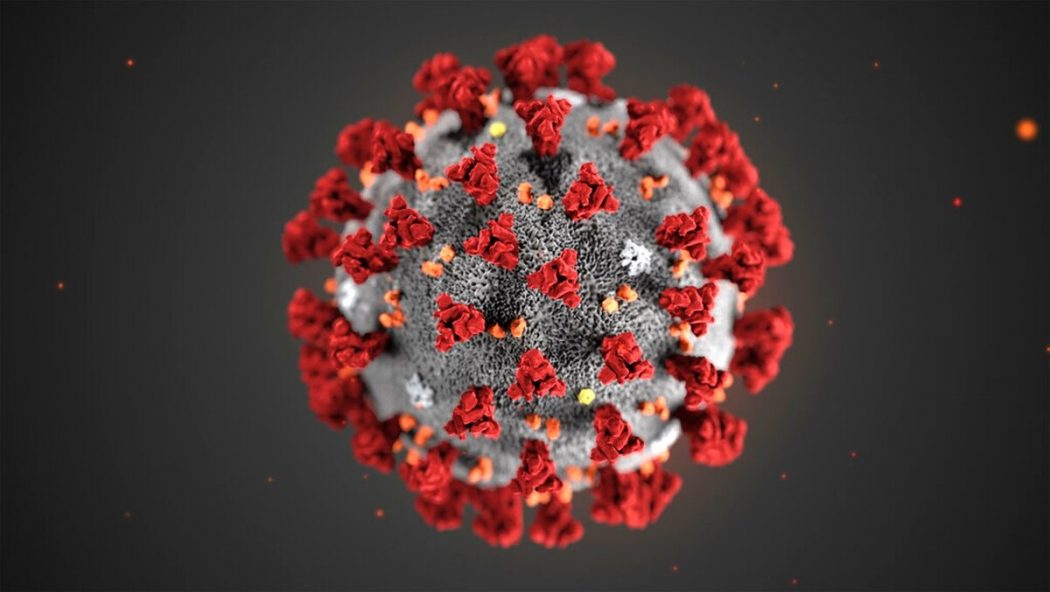I’m sure we all had the same reaction when we first heard of a coronavirus outbreak in China this winter.
The virus with the shortest video in Sketchy Micro? I’m sure that won’t be a big problem.
Well, this positive-sense RNA virus with an envelope and helical-shaped capsid has quickly surpassed the number of cases in either the MERS or SARS epidemics—both due to strains of coronavirus—with over 85,000 cases at the time of writing. It would be futile to write an article on the current spread of the COVID-19 virus in a bi-monthly newspaper like this, as the entire outbreak could be different in the week between writing and publication. So hopefully this article provides a helpful overview of the virus and what we really need to know as medical professionals. Of course, the best resources on the outbreak are from sources that update at least daily, so I’m including some of the best resources upfront before the rest of the article.
Johns Hopkins’ Map of COVID-19 cases
CDC COVID-19 Situation Summary
Coronaviruses have been characterized by virologists for decades, and high diversity of strains is due to the prevalence of various coronaviruses in different species. Bats are commonly named as a culprit for harboring strains, but strains have been found in dogs, cats, pigs, cows, rabbits, rats, turkeys, chickens, camels, and more[1]. Coronaviruses most commonly cause mild upper respiratory illness in humans, essentially causing the common cold. In fact, estimates vary as to the exact proportion, but up to 29% of colds tested in one study were associated with an increase in coronavirus titers [2]. There’s a decent chance you have personally encountered a coronavirus in your lifetime, so why is this current epidemic so worrisome?
To cause clinical infections in humans, viruses have tropisms that dictate which proteins and cell-types they can attack. The coronaviruses that cause minor upper respiratory systems have predominant tropism for the upper respiratory tract. Viruses that have tropism for lower respiratory tract cells have the ability to cause severe viral pneumonia that can be devastating.
The first coronavirus to exhibit this characteristic arose in late 2002 and became known as the Severe Acute Respiratory Syndrome (SARS-CoV). The virus was found to interact with the human protein Angiotensin-Converting Enzyme 2 (ACE-2), allowing it to have tropism for the lower respiratory tract [3]. Symptoms of early SARS-CoV infection include fever, chills, rigor, malaise, myalgia, and cough. Progression of the disease can lead to dyspnea, tachypnea, pleurisy, and atypical pneumonia involving both lungs and a ground-glass appearance on CT scan [4]. If supportive measures are successful in maintaining tidal volume until the lungs heal, patients generally survive. However, mortality rates for SARS were significantly higher than that of most cases of flu, with rates just under 10% for most people and above 50% for patients older than 65 years.
The complex history and politics involved in the 2003 SARS outbreak played a large role in the global spread. In an effort to cover up a burgeoning epidemic, China underreported cases and thwarted efforts to contact world health authorities [5]. This allowed cases to build up in China until it could not be fully contained. For example, in the infamous account of a SARS-CoV case in Hong Kong’s Metropole Hotel, the virus was transmitted to people who would go on to travel to Taiwan, Vietnam, and Toronto [4].
The other coronavirus to gain attention on the national stage was the Middle Eastern Respiratory Syndrome virus, known as MERS-CoV. In 2012 the virus appeared in the Arabian Peninsula and presented as severe respiratory distress with acute kidney injury [6]. The virus was found to have tropism for the protein DPP-4, which helped explain the ability to infect the kidney and the terrifying mortality rate of 34.5% [7]. With such a high mortality rate in a coronavirus, why wasn’t the MERS-CoV the “end of days” virus everyone is anxiously watching out for? Public health efforts to contain the spread were certainly effective, but the transmissibility of the disease was also relatively low. R0—basic reproduction number—is an epidemiological value that estimates the number of additional people one case of a transmissible illness would be expected to infect in a susceptible population. Values less than 1 indicate that a disease will not indefinitely spread in a population. The estimated R0 for MERS is 0.47 (CI = 0.29 – 0.80), so while this virus was significantly more deadly than SARS, it was not likely to cause a widespread outbreak [8].
When what would eventually be named COVID-19 was traced back to a live meat market in Wuhan, China, the country was less withholding than in 2002, and the world was quickly made aware of the impending threat. Due to the rapid response, we have learned more information at a greater rate about COVID-19 compared to previous coronavirus outbreaks. COVID-19 is more related to certain coronavirus strains isolated from bats than it is to either SARS-CoV or MERS-CoV; however, there is significant homology in the S1 binding region to SARS-CoV, which tipped scientists off to the fact that COVID-19 likely also has a tropism for ACE-2 [9]. Symptoms reported from the CDC include shortness of breath, cough, and fever, which are largely indistinguishable from the flu. Like SARS-CoV, severe cases, cases in the elderly, and cases in the immunocompromised can eventually require respiratory support and admission to an intensive care unit [3]. A couple of case studies have demonstrated the possibility of antiviral therapy with lopinavir/ritonavir, with one case demonstrating a marked reduction in quantitative PCR titer levels following therapy [14]. Studying the efficacy of antiviral medication on COVID-19 will take a while, so it may be more worthwhile to seek out the production of a vaccine, although this could take up to 1.5 years to fully develop.
At the time this article was written, the largest study on COVID-19 cases has been released by the Chinese CDC, which includes more than half the total reported cases. They estimated an overall case-fatality rate of 2.3%, increasing to 14.8% for the 80+ age range. It should be noted that accurate case-fatality rates are impossible to exactly calculate until the end of an epidemic, so these numbers are mere estimates. Most interestingly, they found that over 80% of COVID-19 cases are not severe [10]. This bodes well for most people contracting COVID-19, but it is concerning from an infectious disease standpoint because infected people could be unaware that they are carrying COVID-19.
Several other aspects of the COVID-19 virus indicate that its spread will continue for the time being. The incubation period of the virus has been estimated to be 6.4 days (CI 2.1 – 11.2), making it difficult to catch cases early and requiring quarantines of up to two weeks [11]. This fact combined with the knowledge that COVID-19 can be transmitted from an asymptomatic individual indicates the potential for the surreptitious spread of the virus [12]. It should be no surprise that this virus has an R0 estimated between 2.24 and 3.58 [13]. With this value significantly greater than 1, COVID-19 would be expected to spread throughout a susceptible population unless significant disease control efforts are taken. Writing about the current efforts to control the COVID-19 outbreak would warrant an entire other set of articles, so I cannot get too deep in it; however, one discouraging study seems to demonstrate that airport screening using body temperature scanners to check for fevers will fail to detect more than half of COVID-19 cases because of the long incubation period and the possibility of asymptomatic cases[15].
Finally, the most important question about COVID-19: will the outbreak require me to wear an N95 mask and force me to shave my beard, causing my patients’ perceptions of me to go from This young man seems to know what he’s doing to Good Lord! Why is this child in a white coat moving towards me with a needle?
I fear that it is too early to know how prevalent this virus will become, so my beard’s future is yet to be determined. In the meantime, I’ll keep checking this amazing CDC guide for beards and pick out my favorite, N95-friendly style. Right now the frontrunner is “Zappa,” but I am open to constructive feedback.
[1] Saif LJ. Animal Coronaviruses: Lessons for SARS. In: Institute of Medicine (US) Forum on Microbial Threats; Knobler S, Mahmoud A, Lemon S, et al., editors. Learning from SARS: Preparing for the Next Disease Outbreak: Workshop Summary. Washington (DC): National Academies Press (US); 2004. Accessed from https://www.ncbi.nlm.nih.gov/books/NBK92442/.
[2] Monto A.S. (1989) Coronaviruses. In: Evans A.S. (eds) Viral Infections of Humans. Springer, Boston, MA. Accessed from https://link.springer.com/chapter/10.1007/978-1-4613-0705-1_7.
[3] Azamfirei R. The 2019 Novel Coronavirus : A Crown Jewel of Pandemics. J Crit Care Med. 2020;6(1):3-4. doi:10.2478/jccm-2020-0013. Accessed from https://www.ncbi.nlm.nih.gov/pmc/articles/PMC7029402/.
[4] Osterhaus ADME, Ph D, Stöhr K, Ph D. The Severe Acute Respiratory Syndrome. NEJM. 2003:2431-2441.
[5] Welsh E, Allman Updike E. Episode 43 M-m-m-my Coronaviruses. This Podcast Will Kill You. Published Feb 4, 2020. Accessed from http://thispodcastwillkillyou.com/2020/02/04/episode-43-m-m-m-my-coronaviruses/.
[6] Shehata MM, Gomaa MR, Ali MA, Kayali G. Middle East respiratory syndrome coronavirus : a comprehensive review. Front Med. 2016;10(2):120-136. doi:10.1007/s11684-016-0430-6.
[7] Kleine-weber H, Schroeder S, Krüger N, Prokscha A, Naim HY. Polymorphisms in dipeptidyl peptidase 4 reduce host cell entry of Middle East respiratory syndrome coronavirus. Emerg Microbes Infect. 2020;9.
[8] Kucharski A J, Althaus C L. The role of superspreading in Middle East respiratory syndrome coronavirus (MERS-CoV) transmission. Euro Surveill. 2015;20(25):pii=21167.
[9] Lu R, Zhao X, Li J, et al. Genomic characterisation and epidemiology of 2019 novel coronavirus : implications for virus origins and receptor binding. Lancet. 2020;395(10224):565-574. Doi: 10.1016/S0140-6736(20)30251-8.
[10] The Novel Coronavirus Pneumonia Emergency Response Epidemiology Team. The Epidemiological Characteristics of an Outbreak of 2019 Novel Coronavirus Diseases (COVID-19) — China, 2020[J]. China CDC Weekly, 2020, 2(8): 113-122.
[11] Backer JA, Klinkenberg D, Wallinga J. Incubation period of 2019 novel coronavirus (2019- nCoV) infections among travelers from Wuhan, China,. Euro Surveillance. 2020;(January):1-6.
[12] Ryu S, Chun BC, Society K, Force T. An interim review of the epidemiological characteristics of 2019 novel coronavirus. Epidemiol Health. 2019:1-4.
[13] Zhao S, Lin Q, Ran J, et al. Preliminary estimation of the basic reproduction number of novel coronavirus (2019-nCoV) in China, from 2019 to 2020 : A data-driven analysis in the early phase of the outbreak. Int J Infect Dis. 2020;92:214-217. doi:10.1016/j.ijid.2020.01.050.
[14] Lim J, Jeon S, Shin H, et al. Case of the Index Patient Who Caused Tertiary Transmission of Coronavirus Disease 2019 in Korea : the Application of Lopinavir / Ritonavir for the Treatment of COVID-19 Pneumonia Monitored by Quantitative RT-PCR. J Korean Med Sci. 2020;35(6):1-6.
[15] Quilty BJ, Clifford S, Flasche S, Eggo RM. Effectiveness of airport screening at detecting travelers infected with novel coronavirus (2019-nCoV). Euro Surveillance. 2020;(Figure 1):1-6.
Luke Wohlford is a medical student in the University of Arizona College of Medicine - Phoenix, Class of 2022. He graduated from the University of Arizona in 2018 with a Bachelor of Science in physiology. Luke plans to go into emergency medicine has special interests in public health and EMS. He spends most of his free time hanging out with his dogs Kanye and Kelso or feeling guilty about not exercising.


